9+ Sample Used Car Inspection Checklists
-

Sample Used Car Inspection Checklist
download now -
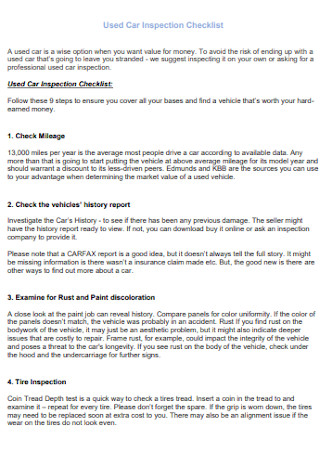
Basic Used Car Inspection Checklist
download now -
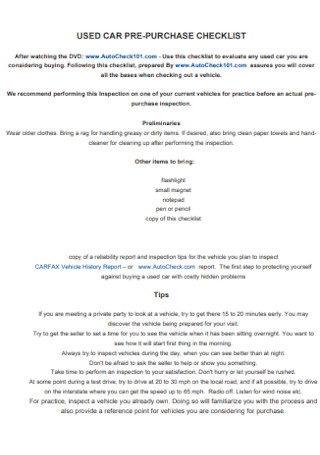
Used Car Purchase Inspection Checklist
download now -
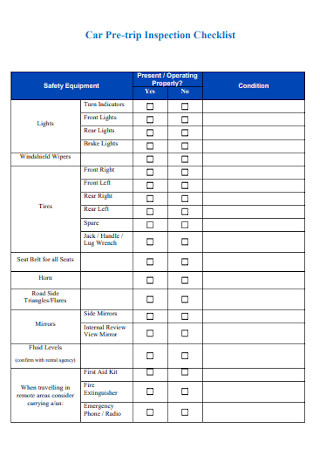
Used Car Pre-trip Inspection Checklist
download now -
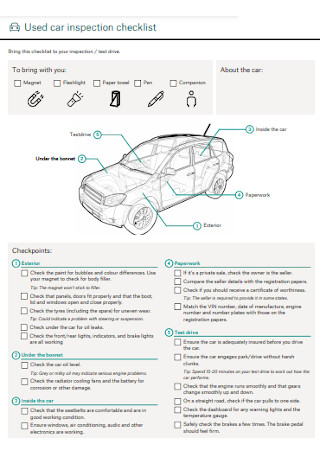
Formal Used Car Inspection Checklist
download now -
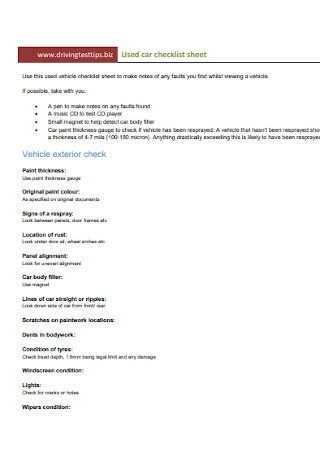
Used Car Inspection Checklist Sheet
download now -
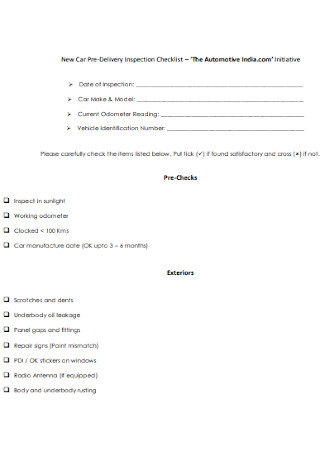
Used Car Pre Delivery Inspection Checklist
download now -
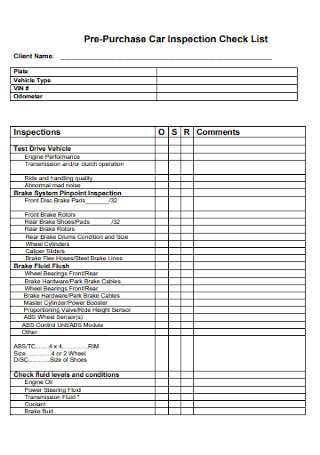
Pre-Purchase Car Inspection Check List
download now -
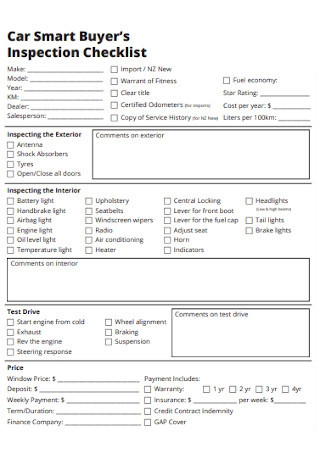
Used Car Buyer Inspection Checklist
download now -
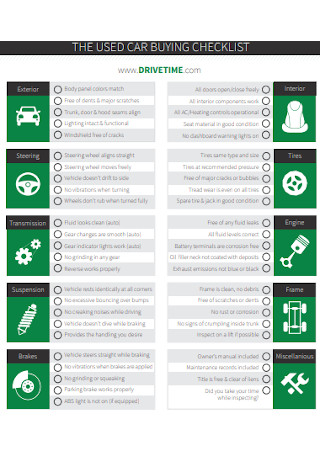
Used Car Buying Inspection Checklist
download now
FREE Used Car Inspection Checklist s to Download
9+ Sample Used Car Inspection Checklists
What is a Used Car Inspection Checklist?
Benefits of Having a Used Car Inspected
What are The Contents of a Used Car Inspection Checklist?
How to Create a Used Car Inspection Checklist
FAQs
Why should you get a used car inspected?
Where can I get a used car inspected?
What is usually checked when a used car is being inspected?
What happens after the inspection is complete?
Can we get away with not using a checklist when inspecting a used car?
What is a Used Car Inspection Checklist?
You’ll usually notice the mechanics at the dealership you’re visiting go through some sort of checklist as they inspect the used car that you’re trying to purchase from them. This is what is known as a used car inspection checklist. It is a document that serves as a very handy guide for them to check the vehicle of your interest for possible issues and defects that may have remained hidden throughout its previous use. Having this checklist readily available is important to make sure that everything in the car that needs to be inspected, is thoroughly looked at by the mechanic.
Benefits of Having a Used Car Inspected
It is very rare that someone just walks into a used car dealership, sees the vehicle of his choice, finalizes the deal and insurance papers, and immediately drives away. It should always be the case that a pre-purchase inspection is done by the dealership’s certified mechanic.
What are The Contents of a Used Car Inspection Checklist?
The contents of a Used Car Inspection Checklist greatly differ between dealerships. Here are the common things found inside:
How to Create a Used Car Inspection Checklist
If you are feeling confident of doing the inspection yourself rather than leaving it to the dealership’s mechanics, or you are eyeing a used car from a private seller, here’s how to create an inspection checklist of your own.
1. Research the used vehicle you’re trying to purchase.
After you’ve found a listing that grabs your attention, and after you’ve expressed interest to the seller, it is time to perform some research on the vehicle. It’s your call whether to make it as simple as possible, or as thorough as you can. But the latter is recommended. After all, you would want to make the deal as smooth as possible. The seller should also agree beforehand to have the car inspected. If he/she is unwilling to do so, the best choice would be to walk away from the deal.
2. Plan about the checklist format.
You’ve done your research about your next eventual vehicle purchase. Great! Now it’s time to think about the checklist that you are going to create. It’s up to you to if you plan on making a short, simple checklist, if you are confident of the private seller’s listing or if the seller has a good reputation on the classified advertising section of a listing website. You can also plan on making it a detailed checklist, listing every possible part and component of the vehicle you’re eyeing, especially if you find out after researching that certain parts of said vehicle are prone to reliability issues.
3. Create the inspection checklist.
It’s up to you to do it by hand or do it digitally. If you’ve chosen to do a short, simple checklist, you can start with the basics (visual checks) and just leave it there. If you’ve preferred to make it as thorough as possible, list everything you can, with particular emphasis on the parts that are consumables and the parts that are prone to reliability issues. You can even resort to making a sketch or a diagram of the used car you’re going for if you prefer to do so. Afterwards, make sure to also leave space at the end of the checklist for you to write your observation reports after you’ve performed your inspection.
4. Verify and proofread your checklist.
Whether you’ve made a simple checklist or a very thorough one, it is still important to verify it. You may have glossed over some things too simply, made some redundant sections, or skipped through an entire section at all. You also could have made your checklist too long and too detailed for your liking. You wouldn’t want this to happen as this can be the difference between a safe ride home or breaking down every 5 kilometers due to a part you haven’t inspected at all.
FAQs
Why should you get a used car inspected?
This is done to make sure that you are kept out from buying a car that’s due for some extensive repair work in the near future, thus saving you some hard-earned cash. It could also uncover issues that are not necessarily dealbreakers, but enough to give you leverage in negotiating for a much lower price. It can also uncover some damages encountered from a previous accident that is intentionally or unintentionally left out of its vehicle datasheet, uncovering compromised parts and components, and potentially saving your life.
Where can I get a used car inspected?
This largely depends on a number of factors. If dealerships are selling used cars, then it is where the pre-sale car inspection will usually take place, with the help of their in-house mechanic. If a private individual is the one selling a used car, you can choose to have the inspection done at his/her backyard with the help of your own mechanic (if you decide to bring one with you) or you can choose to drive the vehicle instead to the dealership and have it done there, as long as the seller is comfortable with it.
What is usually checked when a used car is being inspected?
Generally speaking, you or the mechanic performing the inspection should verify that all the components of the car are in good working condition. Among other things, these usually include the engine, wheels, transmission, suspension, tires, electrical components, and the visual appearance of the used car. A test drive is also essential, to verify the feel and feedback of the car as you put it through its paces. Depending on the dealership, a thorough multi-point inspection can also be performed, which includes the following (but not limited to): Engine, transmission, lights, fluid levels, dents, unusual noises, and corrosion. It is highly important that you (or the mechanic) take your time during inspection of the used car, to avoid unnecessary oversight.
What happens after the inspection is complete?
As the mechanic gives you the inspection report form, or after you’ve done the process yourself, you should be able to decide whether to proceed with the deal or not. If you are satisfied with what you’ve seen and can live with a few minor cosmetic blemishes, then it’s time to negotiate a fairer price. When both parties are satisfied and come to a sales agreement, then congratulations, you’ve earned yourself a new (although used) set of wheels. If there are particular red flags or things that prove to be a dealbreaker that you’ve observed during the inspection, it is advisable to not risk lowballing it. Instead, it is more than okay to walk away from that deal and try to find a new one.
Can we get away with not using a checklist when inspecting a used car?
If you are confident enough with your skills and with what you’re doing, then yes, it is safe with doing away with a checklist. But for most people, especially for new customers in the used car market, it is highly advisable to have a checklist ready to have the process streamlined and to avoid the process of simply eyeballing it during the inspection and calling it a deal immediately.
A Used Car Inspection Checklist is a really important document to have when scouring the classifieds for potential deals. This can help identify what parts of the car are in good working order and those components that can eventually prove to be a massive deal-breaker. If you are struggling to create one for yourself, then please feel free to have a look at the examples being presented above.
